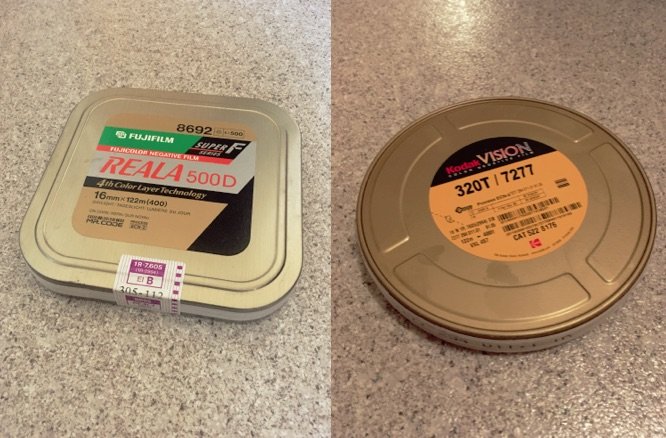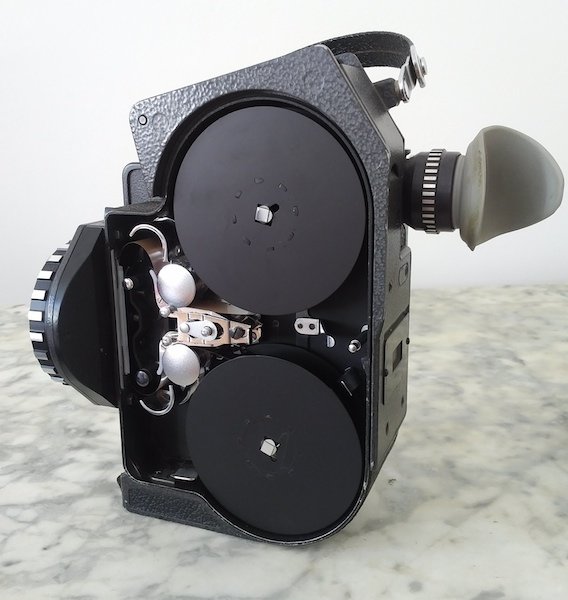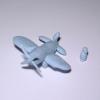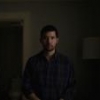Search the Community
Showing results for tags 'Negative'.
-
Glass plate negative: L.O.C. Post processing: D. D. Teoli Jr. The ice box is in the rear. That was when they really used blocks of ice!
-
Hi I have been working only with dark room photography but film processing is quite new. Recently I have been interested in 16mm b/w hand processingd but still I am stuck on primitive level. I am using kodak 7222 negative films now. And I am wondering how I can produce positive film from negative edition. I guess there should be professional duplication machine in the lab. But is it also possible to duplicate(negative to positive or vice versa) by hand processing? I am working alone as it is my hobby so I have no contacts from professional people. It would be appreciated someone let me know detail processes. Thanks!
-
Hi, I'm a filmmaker from Switzerland, I have 7 unopened cans of Kodak Vision 250T and 7 cans of Fuji Reala 500D left over from my grad film project in 2004. Both are 16mm single perf, 122m (400ft). Stored in freezer since. Current condition unknown. Selling for 30 swiss franks per can (=30 USD). Serious buyers only please! Online bank transfer in advance. Minimum order: 3 cans. Shipping to USA costs ca. 40-80 USD, depending on weight. Europe is less. I will be travelling to the UK and US in Feb/March, could possibly bring stock personally (not sure about x-rays?). Best regards Bernie
-
Time for me to sell one of my other Super16 camera : - 1 Bolex EL super 16 mm. Converted from normal 16 to S16 by Les Bosher, UK. Used, some small dents on the surface, but the camera works well. I shot one of my first documentary film with it. About settings : from 10 fps to 50 fps, film speed from 25 asa to 1600 asa, built-in lighmeter. Included : - 1 Bayonet to c mount adapter - 1 battery - 1 battery charger - 1 set of filters holder. Located in Europe. Price : 1000 euros. High res pictures on demand. ( you can e-mail me at : dartwiller@yahoo.fr) I hope my baby gonna find a new home.
-
I'm shooting a project on Vision 3 250D & 500T 16mm soon, we will be scanning to 2K. I've only shot 16 mil once before and am hoping to get something that will look sharper than we got last time. This is what we ended up with last time. http://www.marzmiller.com/ghost (this was also a 1080 telecine, not a 2K scan, processed normally and telecined at Fotokem) Right now I'm thinking of shooting up a stop and a half and pulling one stop, as well as some de-graining in post. Any other ideas on how to get the look I'm going for? I guess the look could best be described as I want it to look like very clean 35mm. We just don't have the dough for 35 this time. - M
-
Does anyone know if using anamorphic lenses on S16mm was common before the release of the Hawk V-Lite16 lenses? I'm looking to shoot a project on these lenses soon and am hoping to use an Aaton XTR, just wondering if it will be easy to find an anamorphic viewfinder attachment for the camera. Or if it would be better to go with a SR camera. A 416 seems to be out of the question for now due to budget reasons. I believe this camera shares the viewfinder design with the SR cameras anyway. (the 416 I used just had SR ground glass in it.) Alternatively what other (if any) Anamorphic 16mm lenses are available in Los Angeles. - M
-
Photoshop levels applied to boost blacks, gentle low-pass filter added to increase sharpness. Maybe my best Tri-X test so far, and a good alternative to the previous gritty Rodinal (APH09) look. I like the poetry in this frame. Out of focus, perhaps due to the fact it is a hand-held panning shot, made in haste whilst the sun broke through he clouds. Of course HC110 is cheap and has a long shelf-life. My sealed glass bottles are now over 2 years old. Note. Pan X in HC110 lacked compared to APH09, so this is a nice surprise. Next up will be D19, later in the week, But maybe it will be hard to match this.
- 15 replies
-
- Super 8
- processing
-
(and 2 more)
Tagged with:
-
Hello, I have a short film shoot set to go to camera early November and we're shooting on Kodak 35mm film. There's a particular scene involving two characters who go out for a night in the city and involves them running through the streets, in china town shops, and restaurants. We've set aside 5219 for those scenes and will be shooting on Zeiss Super Speeds but I'm worried it still won't be enough. So I've thought about push processing. The look of push processing would also aid the story as everything is supposed to feel heightened for the characters. I've never attempted it before so I wanted to see if anyone could help answer some questions: - Does push processing actually get you more image in the blacks or just simply up the contrast? - How many stops should one push to get clear characteristics of push processing (grain, contrast, saturation). I've heard that modern stocks need to be really pushed to their limits before seeing clear results? - Considering I'm shooting 500T, how do I rate the stock for each additional stop? +1 = 1000, +2 = 2000? - Is it even worth it to get the effect chemically or can the same results be achieved in the DI? Thanks for the help! Chris
-
Hi everybody, So at my school I'm going to have the luck to be the DP of a small short in 35mm. The worflow is this : Shoot 35mm the negative is developped and transfered in both mediocre HD for editing and decent 2K for grading and finishing. I know more or less how contrast works when you get a positive from the negative, that is : shooting the same negative at various EI + the positive give different looks (deeper blacks, more or less contrast in the shadows, less grain, more saturation etc etc) So I wonder how this applies when you scan the negative directly. I'll have a 500T, what if I rate it at 250 ? The guy from the lab told be he scans according to the middle gray chart (if we shoot one) What about things like blacks, whites, contrast, visible grain, saturation ? Thanks guys !
-
Myself and John Holland will be taking a tour of Cinelabs, one of the two boutique film labs in London, on the 13th November to see their recently revamped facilities. If anyone would like to join us you'd be more then welcome, please let me know here and I'll add your name to the list.
-
Hey. I've recently shot my first 16mm film, and to our greatest luck, there's a nice big blue artifact in one of the rolls. html5 video http://gfycat.com/ElatedBountifulCowrie better quality stills https://www.dropbox.com/s/ze40zp4554ysb90/artifact_1.1.2.jpg?dl=0 There is actually information under the blue artifact (If you cannot tell by the low quality animation) which makes me wonder how this could happen? (And who's head should roll?) As this is a film school project, I don't have any contact with the lab myself, but they told the teachers it was because the camera wasn't clean. Anybody have any clue or experienced this before? Thanks!
-
I heard from a little birdie that Kodak film cement has recently been discontinued? Does anyone know if this is real and can anyone confirm this? I guess this means the end of negative cutting and cement splicing huh... Unless there is another company that makes film cement that I'm unaware of?
-
Hi All, I currently want to shoot some 16mm Tri-X for an experimental film I'm making. I'm going to do bucket processing, but I want to bucket process as a negative. I keep reading in onine and in other forums here that if you shoot reversal film and want to process as a negative you need to overexpose a little bit when filming. Since I'm shooting this in daylight and the EI for daylight is 200, I was wondering what I should rate my film at. Should I overexpose by 1 stop or 2 stops etc. or would processing it for longer work also? Thanks for the help!
-
Hello, I have navigated through the forum to see if this question was answered before and I have not found anything, if somebody thinks that the question was already answered, please, let me know as I was not able to find any thread. So, I am preparing a project which is going to be shot on 35mm and I would like to cross process negative as reversal stock as it is something I have done before when shooting stills. I know usually people go the other way around and I know that it would be much easier. However, I want to achieve certain tones in the city I am going to shoot at that can only be achieved with that kind of processing and I do not know if it is possible to go that way in cinema labs. I have talked with some labs in Europe and they do not know where I can process negative as reversal. If somebody has done this before, would you mind sharing the contact details of the lab where you processed it and some info you might consider interesting? Thank you very much. Kindest regards.
-
Hello, I'm doing some school project, and I need to know exactly how the processed and developed film negative (preferably Kodak Vision3) looks. Can someone, please, post here some detailed photos of processed and developed film negative that comes directly from camera (no copy)? I would be extremelly grateful!! :wub: What is the main differences between processed and developed negative from camera and distribution copy film stock? Does the distribution copies usually using the same film stock type that is used in camera? Is there some distribution copies on Kodak Vision3? Does Kodak Vision3 contain sound, and if yes, what type? Can Kodak Vision3 (or other camera film negative) contain SDDS or Dolby Digital sound, or just analogue optical audio? Many thanks in advance for all your replies!!
-
I am seeking some advice/input on the possibility of developing Super 8 Tri X film at home using the Caffenol C-H recipe. I am experienced in developing 35mm Tri-X Negative film (for still photos) using this recipe and have gotten results that I am happy with. I am looking to shoot some Tri-X Super 8 film which I know is reversal. Say I am only looking to get a negative, would my same process (wash, dev, stop, fix, rinse, wash, dry) for still 35mm Tri X work with Super 8? Will I get a useable negative? Could I stuff the film into my 20 oz developing tank that I use for my 35mm rolls? Or would I need to buy something a bit bigger? Thanks.
-
Gentlemen (and ladies), as some of you know I have shot on film and digital. My first short was shot on super16 way back in 2001 and I had a 35 blowup for festivals. A little trailer I cut in December from an HD scan of our blowup... http://www.youtube.com/watch?feature=player_embedded&v=tMFRPMHTiZ0#! Over the last three years I have shot a number of shorts, some using DSLRS and some 8mm (a format I love). Right now I am in talks with some people about a feature film project and while everyone wants to shoot on the RED EPIC, just because the EPIC is cool and easy and cheap (uh, yeah, ok), I want to shoot one of the three acts on film. The story lends itself to this as we need a different look for each act. I also want to be able to say "we shot on film" not only because it's an interesting talking point, but also because before long I think it won't be possible. What I need to know is this: What would you advise as the cheapest solution and workflow for shooting on Super 16? 35mm is out, naturally, due to cost. I like the look of super 16 and it's easy to find lenses in the NYC area. Back in 2001 when I shot my first short the negatives were processed, given a one light with time code and we edited in AVID. Then the negative was cut AB style and we bypassed creating a positive (because I was out of money) and made a 35mm print from the AB rolls. (For a feature we clearly would not have been able to skip the positive step) It is now my understanding that traditional negative cutting is almost never used today. ??? The people involved with this planned film are almost 100% RED and 5D people and as you can imagine, mostly low low budgeters. Those that have shot on film were not in any way involved with post. So I go to you for ideas! I hear things like, "It's too expensive to scan all that negative and color correct it." So how about photo chemically, like it used to be done? "No that's too expensive too." Etc. etc. Thanks for your help.
-
What was the dynamic range of color film negatives used in the 70's like? If I'm correct newer film negatives can have a dynamic range up to 14 stops. What about in the 70's? For example, how did Eastman Color Negative 5254, 5247 or Fujis 8517 perform at this department?
-
Looks like Kodak wants us to get excited. Here's a video of the assembly line for 50D.














